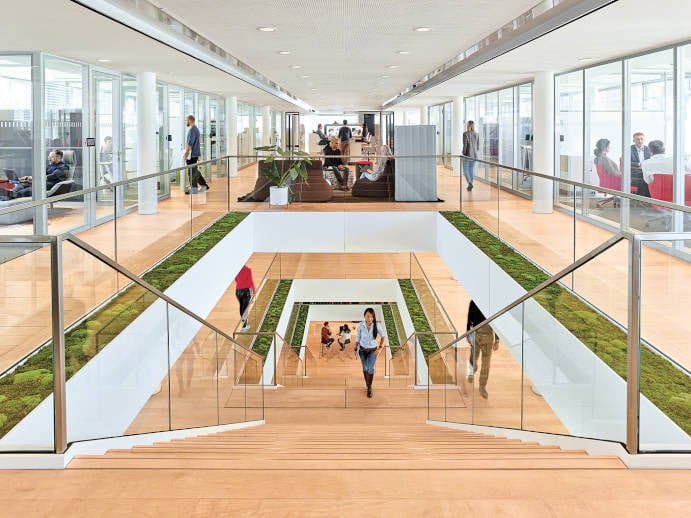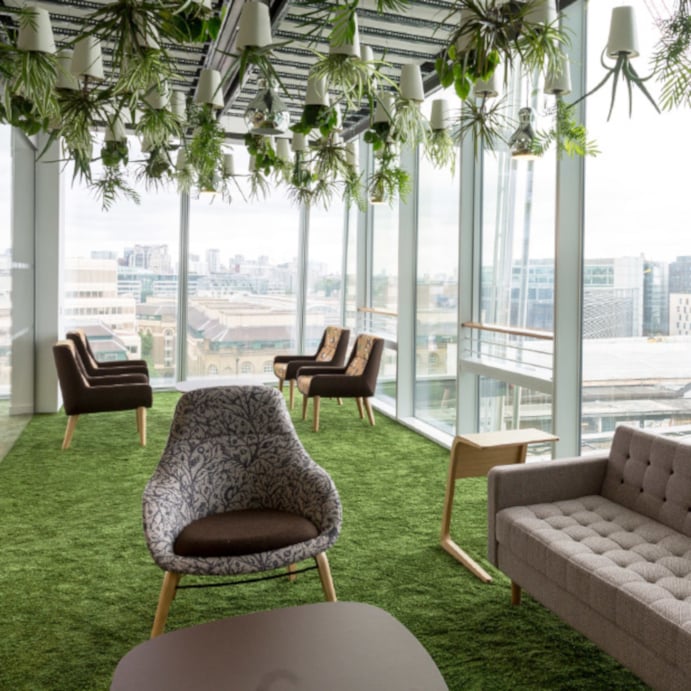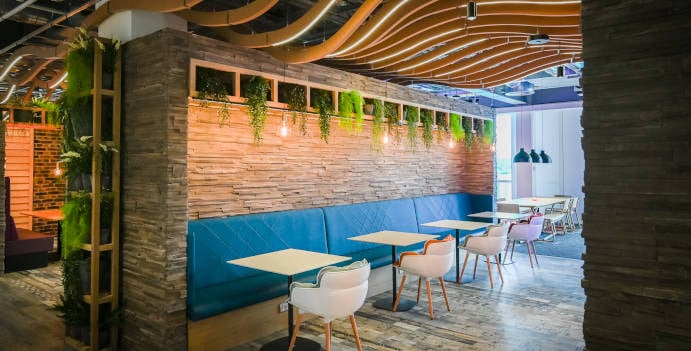Biophilic design has been creeping up the corporate agenda in recent years. But its theory and practice promises much more for organisations than the strategic deployment of vegetation for aesthetic effect.
Inspired by the work of the radical American biologist Edward Wilson - its focus on the empowering effects of natural elements in design and strong environmental credentials feels particularly relevant in this current time of ecological crisis.
What is biophilic design?
Biophilic design purposefully weaves materials, colours, textures and shapes drawn from, and inspired by nature, into the built environment. It reflects the basic human need for sustainable engagement with the natural world and its myriad, health-giving and rejuvenating qualities.
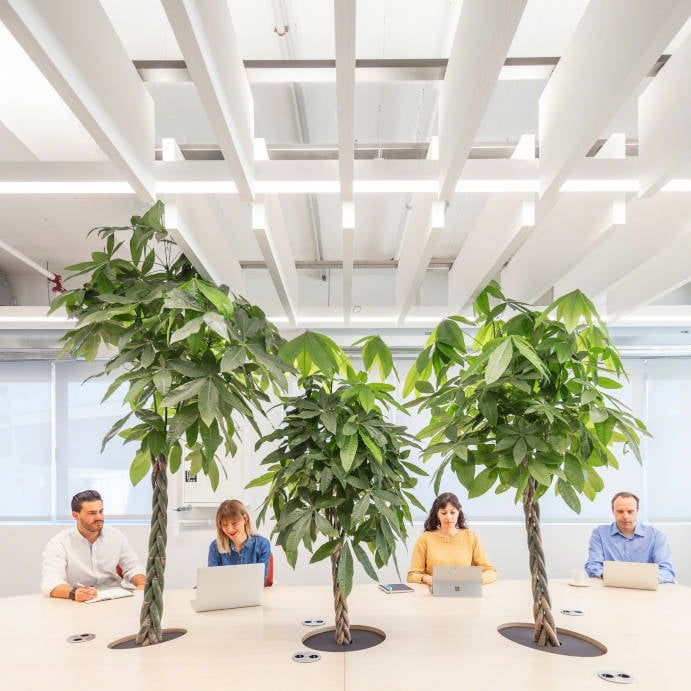
For years workers have felt the ill-effects of inhabiting environments built without regard for access to natural light, views of the outdoors, fresh air or foliage. Research and interviews for this article produced many such stories:
“One woman worked a clerical job in a windowless office basement in Columbus, Ohio. Every day, feeling starved of natural light and greenery, at lunch time she would go on Google Street View and virtually drive down leafy, English country lanes. She said it helped her relax and recharge”
The hack may be unusual, but the workplace experience is far from rare. Indeed, the Human Spaces researchers have shown that globally 47% of workers have no access to natural light, while 58% have no plant life within the spaces where they spend most of their waking hours.
And the effect these kind of environments have on our mental health can be significant.
The same Human Spaces study found that 16% of workers in buildings with restricted access to greenery or daylight reported feeling anxious or demotivated every time they entered their workplace.
Meanwhile, the energising and life-giving properties of contact with nature as part of the built environment, are equally compelling:
- Studies show hospital patients with beds by windows recover faster than those without.
- Workers in a U.S. study who were given access to indoor gardens at their offices reported measurable improvements in their personal wellbeing (85%) and the quality of their working relationships (77%).
- Another study showed people who had access to "greenery and sunlight" throughout their working day were 15% more creative than those who did not.
- Researchers in Attention Restoration Theory have concluded that exposure to tranquil, natural environments can recalibrate the brain after draining mental activity, restoring our capacity to think and helping us to better focus on new tasks.
The biophilic revolution
Designers, academics, workplace consultants and the C-Suite themselves are beginning to understand and explore the potential of natural elements to spur productivity, creativity and wellness in the workplace in unique ways.
The surge of interest in environmentalism and well-being has led to eye-catching corporate, biophilic building projects underpinned by grand ecological visions, for example at the Apple HQ in Cupertino.
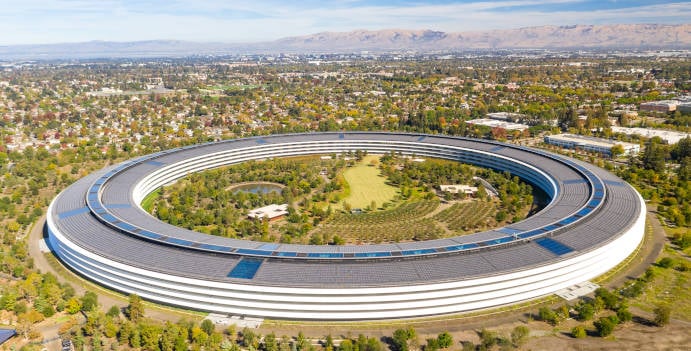
Bring the outside in
But significant breakthroughs can be made in this area without the need dramatic architectural statements.
A focus on a mix of colours, patterns, and organic materiality within the design schemes of workplace interiors can trigger more calming and receptive mental states for those who need to occupy them and bring multiple benefits to employers as a result.
Materiality - Organic materials incorporated into workplace design can evoke the restorative peace and tranquility of the outdoors. These designs use tactile, irregular, unfinished wood and stone surfaces to achieve their effects. The use of plants within boundaries and living wall structures can bring feelings of lushness to normally sterile spaces. Preserved mosses are low maintenance alternatives to achieving these kind of vibrant 'living' green finishes.
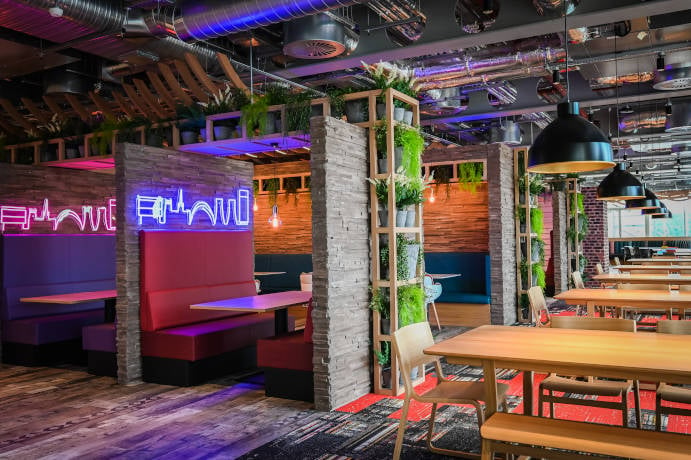
Lighting and acoustics - Biophilic effects can be created through the use of lighting, protecting us from harsh, unnatural screen glare or directing organic light sources to illuminate specific activities more effectively. We can filter light through natural barriers like foliage or reflect it on watery surfaces to create calming or meditative atmospheres. In the same way natural screening with plants and wood can control sound and insulate workers from unwanted noise in a highly effective way.
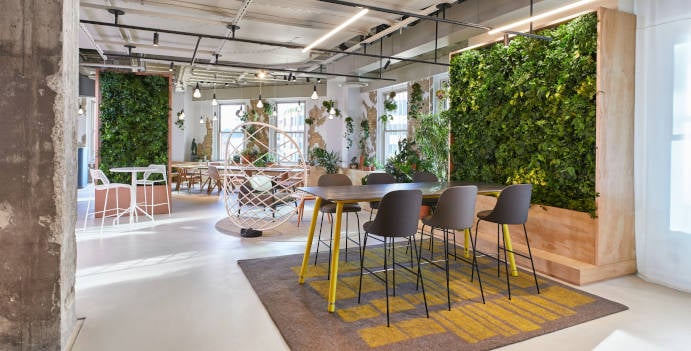
Colours and patterns - Beyond the literal interpretation of the biophilic trend is the use of colour, shapes and patterns to access deeper, hard wired human responses and emotions. Certain colours are widely understood to be more conducive to certain kinds of activities and mental states than others.
Professor Steven Kellert argues muted earth colours are favoured by humans because of their suggestion of the natural world - greens, tawny golds, the blues of skies and water. They can mentally liberate us while making us feel relaxed and connected to a place in quite a visceral way.
The psychologist Judith H. Heerwagen has even suggested the primal memory of the African savanna could be harnessed within particular abstract designs, for example, those that recall tree canopies to unconsciously stimulate feelings of safety and security.
Biophilic inspiration can bring different kinds energies to different kinds of workspaces - from creatively stimulating, light, bright and airy environments - to those which are lush, still and more contemplative in feel.
It can help create the ecosystem of spaces where workers can find the optimum conditions for the different tasks they need to perform throughout the day.
A workspace that reflects your company's values and priorities
For organisations with ambitions to lead their market, engage their existing talent (and attract more of the same), biophilic design can help companies create a more distinctive and engaging employer branding. The attention to detail expended on creating healthful and sensitively designed working experiences demonstrates a real commitment to the individuals and teams you rely on to deliver results. The sustainable choices of natural materials encouraged through biophilic design can also signal a commitment to the highest ethical standards that will enhance your CSR credentials amongst your workers and the wider industry,
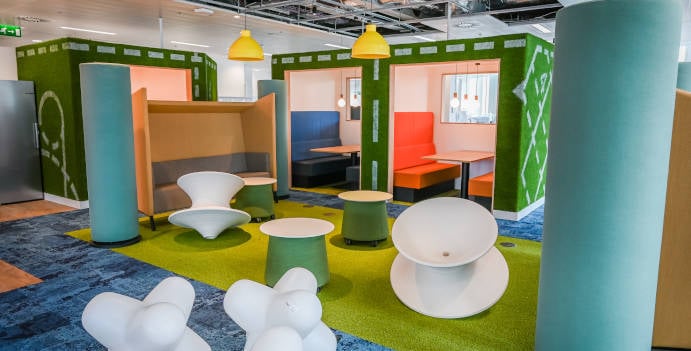
The rewards of the biophilic approach
As IE's Design Director, Nichola Plummer remarks:
"It can certainly be challenging to introduce biophilic elements into modern offices with their traditional partitions, and steel-gridded, tiled ceilings. But it's the very uniformity and sterility of these environments that this design practice seeks to address. With this approach we are able to help companies transform their spaces and the experiences of the people who work within them in unexpected and exciting ways."
And if, as Edward Wilson says:
“Nature holds the key to our aesthetic, intellectual, cognitive and even spiritual satisfaction.”
then the workspaces that weave organic materials and echos of the natural world into their fabric and design, can reap far deeper rewards.
